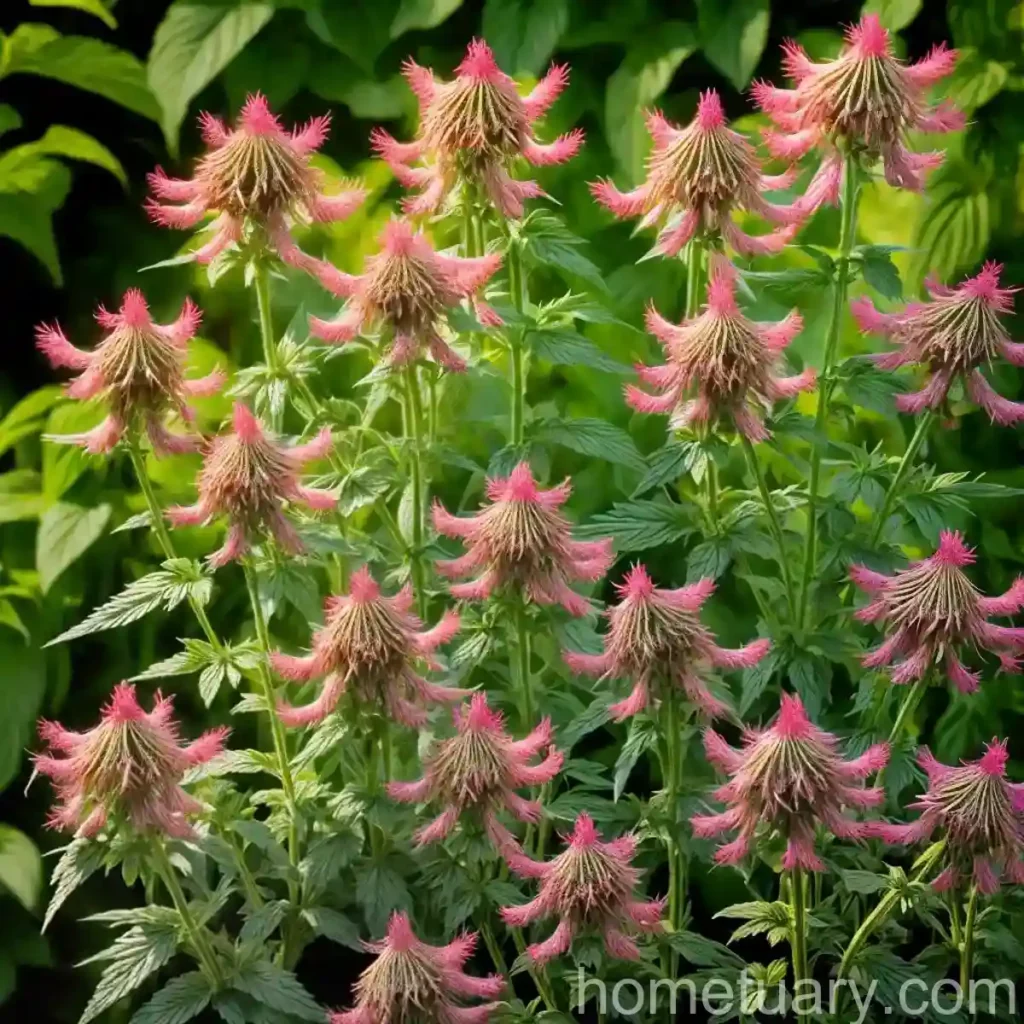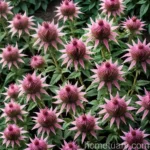Wild Bergamot (Monarda ‘Fireball’): All You Need to Know
Wild bergamot, scientifically known as Monarda ‘Fireball’, is a stunning and versatile perennial plant that adds vibrant color and delightful fragrance to a garden. This plant, a cultivar of Monarda didyma, is prized for its bright red flowers and its appeal to pollinators. In this comprehensive guide, we will delve into the key aspects of wild bergamot, including its culture, uses, care requirements, and common pests and diseases. Whether you’re a seasoned gardener or a novice plant enthusiast, this article is your go-to resource for cultivating and enjoying the beauty of wild bergamot.
What is Wild Bergamot (Monarda ‘Fireball’)?
Wild bergamot (Monarda ‘Fireball’) is a treasured perennial in the horticultural world, renowned for its striking appearance and multiple uses. This cultivar is a member of the mint family (Lamiaceae) and is native to North America, particularly in the eastern regions. It is commonly referred to as bee balm due to its high appeal to bees and other pollinators. The ‘Fireball’ variety specifically features vibrant red flowers that add a pop of color to any garden.
Key Takeaways – Wild Bergamot (Monarda ‘Fireball’)
Before we delve deeper into the specifics of caring for and using wild bergamot in your garden, let’s outline the key takeaways related to this captivating plant. Understanding these fundamental points will set the stage for effectively cultivating and enjoying the beauty of wild bergamot.
- Scientific Name: Monarda ‘Fireball’
- Common Name: Wild Bergamot
- Family: Lamiaceae
- Native Range: Eastern North America
- Type: Herbaceous perennial
- Notable Characteristics: Vibrant red flowers, strong attractant for pollinators, aromatic foliage
- Uses: Ornamental gardening, attracting pollinators, herbal and culinary applications
With the foundation laid out, let’s explore the various aspects of wild bergamot, starting with its cultural requirements.
Culture
Understanding the cultural requirements of wild bergamot is crucial for nurturing healthy, vibrant plants that thrive and flourish in your garden. From water and sunlight needs to soil and pruning considerations, here’s a comprehensive overview of the cultural aspects of growing Monarda ‘Fireball’.
Water
Wild bergamot thrives in moist but well-drained soil. During the growing season, it benefits from regular watering to keep the soil consistently moist. In hot and dry conditions, particularly during the summer months, additional watering may be necessary to prevent the soil from drying out completely. Adequate moisture is especially important during the plant’s flowering period to support robust bloom development.
Sunlight
This cultivar of Monarda didyma ‘Fireball’ thrives in full sun to partial shade. It typically requires at least 6 hours of direct sunlight each day to promote optimal flowering and overall plant vigor. While it can tolerate some shade, prolonged periods of shade may result in reduced flowering and potential issues with mildew, a common problem for plants that lack adequate air circulation and sunlight exposure.
Fertilizer
When it comes to fertilizing wild bergamot, a balanced, all-purpose fertilizer applied in spring as new growth emerges can help support healthy, vigorous growth and prolific flowering. It’s essential to follow the manufacturer’s recommendations regarding application rates to avoid over-fertilizing, which can lead to excessive foliage at the expense of flowers. Additionally, incorporating organic matter into the soil during planting or as a topdressing in early spring can further enhance the plant’s nutrition and soil structure.
Soil
Wild bergamot prefers rich, well-draining soil with a slightly acidic to neutral pH range. Amending the soil with organic matter, such as compost or well-rotted manure, can improve its structure and fertility, creating an ideal growing medium for Monarda ‘Fireball’. Furthermore, ensuring good drainage is crucial, as waterlogged soil can lead to root rot and other detrimental issues.
Pruning
Pruning is an essential aspect of maintaining wild bergamot’s health and appearance. Regular deadheading, the removal of spent flowers, not only promotes continuous blooming but also prevents the plant from setting seed, which can reduce its vigor. Additionally, cutting back the stems in late spring or early summer can help control the plant’s height, stimulate bushier growth, and reduce the risk of powdery mildew, a common ailment that can affect Monarda varieties.
Propagation
Wild bergamot can be propagated through division, stem cuttings, or seed. Division is typically the most common and straightforward method, best done in early spring or early fall. Stem cuttings, taken from healthy, non-flowering shoots, can also be used to propagate the plant. When collecting seeds from the spent flowers, it’s important to note that the resulting plants may not remain true to the parent plant, as Monarda species can cross-pollinate with other varieties. Regardless of the propagation method chosen, ensuring appropriate growing conditions, including adequate moisture and warmth, will support successful establishment and growth of new plants.
Container Popularity
The compact nature and striking appearance of Monarda ‘Fireball’ make it an excellent choice for container gardening. Its vibrant red flowers add a bold splash of color to patio areas, balconies, and other outdoor spaces. When cultivated in containers, wild bergamot requires regular watering to maintain soil moisture, as containers tend to dry out more quickly than garden beds. Additionally, a well-draining potting mix and a sufficient-sized container to accommodate the plant’s root system are crucial for the plant’s health and development. Container-grown wild bergamot can be particularly appealing for gardeners with limited outdoor space or those looking to create eye-catching floral arrangements on decks and patios.
Common Diseases
Despite its inherent beauty and appeal, wild bergamot, like many plants, is susceptible to certain diseases that can affect its growth and overall health. Recognizing the symptoms of common diseases and taking proactive measures to prevent or address them is essential for maintaining robust, flourishing plants. Some of the notable diseases that can impact Monarda ‘Fireball’ include:
- Powdery Mildew: A fungal disease that presents as a powdery, white coating on the leaves and stems, particularly in warm, humid conditions.
- Leaf Spot: Caused by various fungi, leaf spot leads to the development of dark spots on the foliage, potentially causing leaf yellowing and premature drop.
- Root Rot: Excessive soil moisture, especially in poorly draining soil, can lead to root rot, resulting in wilting, yellowing, and eventual death of the plant.
Disease Diagnosis
It’s essential to be vigilant and observant when monitoring your wild bergamot plants for signs of disease. Early detection and prompt intervention can significantly improve the plant’s chances of recovery. When diagnosing potential diseases, carefully inspect the foliage, stems, and overall plant appearance for any irregularities or symptoms. If you notice any concerning signs, such as abnormal discoloration, spots, or growth abnormalities, take the following steps:
- Isolate Affected Plants: If you suspect disease, move the affected plant away from healthy ones to prevent potential spread of the issue.
- Consult a Plant Professional: Seek advice from a local plant nursery, agricultural extension service, or plant pathologist to help identify the specific disease and receive recommendations for treatment.
By promptly addressing any suspected diseases and taking appropriate remedial action, you can help safeguard your wild bergamot plants and prevent the spread of ailments to other garden specimens.
Common Pests
In addition to diseases, wild bergamot can be susceptible to pests that may compromise its health and vigor. Some of the common pests that may affect Monarda ‘Fireball’ include:
- Aphids: These small, sap-sucking insects can congregate on the tender new growth of wild bergamot, leading to stunted growth and distortion of leaves.
- Spider Mites: Often prevalent in hot, dry conditions, spider mites can cause stippling and yellowing of the foliage, potentially weakening the plant.
- Powdery Mildew: Though primarily a disease, the presence of powdery mildew can also attract secondary pests, such as spider mites and aphids, further complicating the plant’s health.
Botanist’s Tips
As a plant scientist deeply passionate about horticulture and the fascinating world of plants, I can’t help but share some insightful tips for cultivating and appreciating the beauty of wild bergamot. These tips aim to further enhance your experience and success when growing Monarda ‘Fireball’ in your garden:
- Encourage Pollinators: Incorporate an assortment of nectar-rich, pollinator-friendly plants alongside wild bergamot to create a thriving habitat for bees, butterflies, and other beneficial insects.
- Practice Good Air Circulation: To minimize the risk of powdery mildew and other foliar diseases, space plants adequately and avoid overcrowding, promoting good air circulation around the foliage.
- Harvesting and Use: Wild bergamot leaves can be harvested for herbal teas, adding a delightful flavor and aromatic essence to your brew. The flowers can also be used as a colorful, edible garnish in salads and desserts.
- Mulching: Applying a layer of organic mulch around the base of wild bergamot helps conserve soil moisture, suppress weed growth, and insulate the roots, contributing to healthier, more resilient plants.
- Wildlife Integration: Wild bergamot is a valuable addition to wildlife-friendly garden designs, attracting various pollinators and contributing to the ecological balance of your outdoor space.
Fun Facts
To further deepen your appreciation for wild bergamot, here are some engaging and intriguing fun facts about this remarkable plant:
- Wild bergamot, particularly the Monarda didyma species, has a rich history of traditional medicinal uses among many Native American tribes. It was employed for a wide range of ailments, including fevers, respiratory issues, and digestive discomfort.
- The name “bergamot” is derived from the resemblance of the plant’s aromatic foliage to the renowned bergamot orange, known for its use in flavoring Earl Grey tea.
- Among its many common names, wild bergamot is also referred to as “bee balm,” stemming from its strong allure to bees and its historical use as a soothing balm for bee stings.
Links to External Resources
To supplement your knowledge and delve further into the world of wild bergamot, I’ve curated a selection of authoritative external resources. These links provide valuable insights, practical tips, and in-depth information to support your exploration and cultivation of Monarda ‘Fireball’:
- The Royal Horticultural Society – Monarda – This resource from the RHS offers comprehensive guidance on the cultivation, care, and ornamental value of Monarda ‘Fireball’.
- University of Maryland Extension – Growing Bee Balm – An informative guide from the University of Maryland Extension that delves into the cultural requirements, propagation, and pest management for bee balm, including Monarda ‘Fireball’.
- USDA NRCS – Monarda didyma – Explore detailed botanical information, native range, and ecological significance of Monarda didyma from the USDA Natural Resources Conservation Service.
I hope this guide has provided you with a comprehensive understanding of wild bergamot (Monarda ‘Fireball’), from its cultural requirements and uses to its potential pests and diseases. By incorporating this striking perennial into your garden, you can enjoy its vibrant blooms, support pollinators, and savor its myriad applications in ornamental, herbal, and culinary contexts. As you embark on your wild bergamot journey, remember to embrace its beauty, fragrance, and ecological contributions while fostering a thriving, diverse garden ecosystem. Happy gardening!















